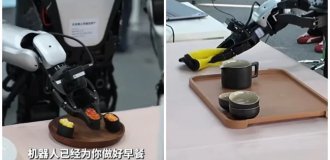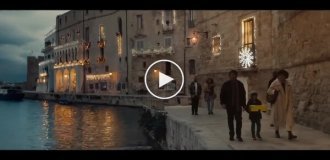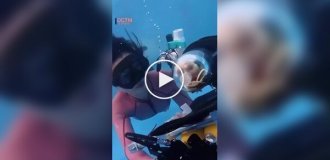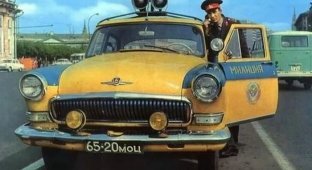At a motorcycle museum near the Spanish city of Guadalest, a canister caught my attention. An ordinary 20-liter canister that stood as a support for a trailer for a military motorcycle.

Just a canister. Only it was exactly like the two canisters stored in my garage at the dacha. They are also like twin sisters - shape, color... only one has 20L stamped on its side, and the other has 20L. That's the whole difference. I got one from my father, the other from the German Red Cross. And in Spain it’s exactly the same.
Who invented them? It turned out, yes, the Germans again.
It all started in the mid-30s, when all world powers began to gradually prepare for the impending world war. Everything said that this would be a “war of engines” and a lot would depend on optimizing fuel supplies. At the end of 1936, on the initiative of the German command, a competition was announced to develop a new tank for storing and transporting fuel by Wehrmacht troops. It was necessary to create a metal canister with a capacity of 20 liters. At the same time, simplicity of design and low production costs had to be ensured.
Among others, the Müller company from the city of Schwelm took part in the competition. Designer Vinzenz Grünfogel proposed his own version of the canister, with a number of positive features. The minimum number of seams reduced the likelihood of leaks. The empty canister weighed only 4 kg, and the shape allowed the canisters to be stacked with maximum efficient use of space. Three handles made it easy to carry both empty and full canisters: one person could carry the canister by the central handle, two by the side handles. In addition, it was possible to carry two empty canisters at once with great convenience in one hand.
The main elements of the canister designed by Grünvogel were two stamped side parts of complex shape. There were stiffening ribs on the surface of these parts. The rigidity of the structure was ensured by X-shaped stampings and a specific shape of the edge of the side parts, concave inward. The latter feature also made it possible to recess the main weld seam inside the volume limited by the outer walls of the canister. The neck cover was hinged, equipped with a rubber seal and secured with a swing lock. A pin in the form of a metal rod with a ring made it possible to block the lid lock to prevent it from being opened arbitrarily. Inside the neck there was one end of a special siphon tube, which was intended to facilitate filling and emptying the canister. The simplicity of the design made it possible to produce such canisters even in conditions of shortage of quality materials.
Despite its simplicity, the new canister had many advantages over existing containers. The characteristic shape of the product, inscribed in a parallelepiped, made it possible to store empty and filled canisters with the most efficient use of the available space. And this is very important in the business that is now called the word “logistics”, but at the time when I had to study such a subject as “Car Service”, it was simply called supply.
The new canister had other advantages - the rounded corners reduced the likelihood of damage to the canister itself and surrounding objects. There was always air left in the upper rear part of the canister body, which made it possible to compensate for changes in the volume of liquid under the influence of temperature.
Despite the fact that the Wehrmacht at that time already used 20-liter triangular fuel canisters, the simplicity and manufacturability of the Grünvogel canister pleased the German command so much that already in 1937 the new product was launched into a series called Wehrmachtskanister (“Wehrmachtskanister” (“Wehrmacht Canister”) ).

Various inscriptions were stamped on the side surfaces of the Wehrmachtskanister, but first of all the volume was 20L. To avoid confusion - for example, to avoid pouring gasoline into a water container - the canisters could be painted in different colors.

The German military was in no hurry to announce the existence of a new canister with a simple but successful design. Only in 1939, several of these products disappeared from one of the German warehouses and went to the Americans. There is a whole detective story connected with this.
An American engineer named Paul Pleiss worked under contract in Germany. In 1939, shortly before the outbreak of World War II, his contract was ending and he had to return back to the United States.
But, for some reason, Pleiss was in no hurry to return home. He, apparently having a thirst for travel, decided to assemble a car and arrange a Berlin-Calcutta run with it. I bought a car chassis in Germany and built a body adapted for a long journey. He began to get ready for the trip, and it turned out that he did not have suitable containers for storing fuel and water. One German engineer helped out, whom Pleiss persuaded to accompany him on the run to India. This engineer had access to one of the warehouses at Tempelhof Airport in Berlin, which he took advantage of. He “borrowed” three cans from the warehouse, which ultimately made his friends’ trip to India more comfortable.
But soon after the friends left for their run, a scandal broke out at Tempelhof airport - despite the large number of canisters in the warehouses, three canisters were noticed missing. As a result, several German military personnel were sent in pursuit of the international crew.
Pleiss and his German traveling companion had by this time traveled through more than a dozen countries and were approaching the finish line. At that moment, the German somehow received a message that he urgently needed to return to his homeland, and he left Pleiss. The further fate of the German engineer, like his name, is unknown for certain. However, the further actions of engineer Pleiss are known. After reaching Kolkata, he stored the car and went to the USA. The canisters remained in the car.
Apparently, the German canister made a huge impression on Pleiss, as an engineer. At home in Philadelphia, he tried to interest officials in her. But verbal descriptions and drawings did not impress anyone. The American command had no idea what problems the troops would face in just a couple of years, and therefore showed no interest in the original canister.
Pleiss was forced to organize the transportation of his car and canisters left in Calcutta to America. In the summer of 1940, the German canister was finally presented to the leadership of the US Army in its natural form, but this did not produce any results. The command decided to continue using the existing 10 gallon (37.8 L) containers.
However, some US enterprises became interested in the secret German development. The designers of these enterprises creatively reworked Grünvogel's invention - the changes consisted of abandoning the main body weld in favor of a rolled connection and instead of the original German neck and cap, a large diameter threaded cap was used.

The canisters were produced in this form for some time, but then American enterprises were forced to master the production of more accurate copies of the German design.
In 1940, the existence of Grünvogel’s invention became known in Great Britain. Soon after the start of the war, a number of captured canisters found their way to British enterprises, where they were studied. The British did not try to split hairs like the Americans, but tried to copy the canisters as quickly and accurately as possible and begin their mass production. It is known that already at the beginning of 1943, the British troops fighting in North Africa received the first few shipments with a total volume of about 2 million canisters.

The emergence of simple and reliable fuel containers became one of the most important factors determining the success of combat operations. Shortly before this, an inspection checking the logistics organization of Montgomery's army discovered that fuel losses due to imperfect packaging reached 40%. Gasoline was then transported from the coast to army bases by rail in standard 200-liter barrels, after which it was bottled into containers that had been used for centuries in Britain to store household kerosene. In such cans, fuel overheated in African conditions, spilled, and flowed through broken seams.

The production of German-style canisters was carried out in the most active manner. According to various estimates, at the beginning of May 1945, there were up to 20-21 million such canisters in Europe. By this time, such containers were actively used in all warring armies and quickly replaced all existing ones.

Wehrmachtskanister canisters received the nickname Jerry-can among the Allied troops, derived from a slang nickname for the Germans. This name is still used to refer to Grünvogel's original product and developments based on it. However, the name "Jerry Can" is only used in English-speaking countries. In our country and in the post-Soviet space, such containers are simply called canisters, without specifying the origin.
It is believed that German-style canisters appeared in the Soviet Union some time after the start of deliveries under Lend-Lease. Along with foreign-made equipment and raw materials, our country received various auxiliary products, including fuel containers.
But I think the first captured canisters appeared in the Red Army immediately after the start of the war. I remember when I was a child, I read a story or story - a description through the eyes of a Moscow boy about the first ten days of the war. How differently people perceived the beginning of the war, how the first air raid warnings were announced, how the boys ran to the first exhibition of captured equipment... There was an interesting episode in this story, how in the middle of a Moscow courtyard one local self-taught inventor, having obtained a crumpled trophy canister somewhere, made it acquire its original shape by pouring a little water into it and placing it on an ordinary primus stove placed in the middle of the yard. And how he rejoiced at his successful experience, assuring that now the Red Army would be able to use even damaged captured canisters.















































